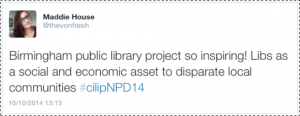INSTG012 Historical Bibliography Visit to St Bride’s Printing Library by Simone Charles
By Anne Welsh, on 14 November 2014
On Monday 13th October, 2014 as part of our Historical Bibliography module, half of the class visited St. Bride’s Printing Library on Fleet Street, while the other half visited the British Library. As I was part of the group that visited St. Bride’s, I felt compelled to write about the experience there as it clearly impacted on the learning objectives of the course.
St. Bride’s Library, which opened its doors to the public as a printing school in 1895, is part of the St. Bride Foundation. On arrival we were met by our facilitators, Bob and Mick, who both had no hesitation in describing and demonstrating some of the collections. We were shown excerpts of the Catnach, Kindersley as well as the Gill Collections, all of which were unique in their own right.
Of particular interest to me was the Catnach Collection as his broadsides are forerunners of tabloids in the United Kingdom. From the plain and simple to the gory, this collection is quite remarkable and is well preserved along with the other collections.
Despite this wealth of materials, the aspect of the visit that peaked our interest the most was that of the printing press room. This room which could most certainly also be described as a small museum, has working original models of hand presses used between the 18th and 19th centuries. These include the Columbian Press (1822), the Albion Press (1828), and the Stanhope Press (1830). The Library is also home to an immaculate wooden Compositor’s Box from Oxford University Press.
Additionally, we were shown some wood engraving techniques whereby blocks of wood were engraved with various illustrations, placed between text and hand pressed during the Victorian era. Our visit then closed with each of us hand pressing selected designs given to us by Rob and Mick.
Having read and researched 19th century newspapers from Trinidad and Tobago over time, I never actually thought of the actual process that went into printing. This visit to St. Brides was truly an enlightening one and can serve to be a true asset to anyone wishing to delve into the field of Rare Books and Special Collections Librarianship or to become knowledgeable in the history of the printing press on a whole. For further information on the library please visit http://www.sbf.org.uk/library or follow them on twitter (@stbridelibrary) or facebook.
—-
Simone Charles (@libraryesque) is studying for her MA LIS, specialising in Bibliography, Book History and Cataloguing.
Note: the appearance of the byline on this post is auto-generated, indicating that it was posted by Anne Welsh. Simone Charles is the sole author of this piece.
 Close
Close













